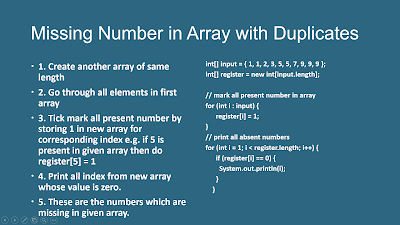How to Find Multiple Missing Integers in Given Array of Numbers with Duplicates in Java?
It's been a long time since I have discussed anycoding oralgorithm interview questions, so I thought to revisit one of the most popular array based coding problem of finding missing numbers in a given array of integers. You might have heard or seen this problem before on your programming job interviews and you might already know how to solve this problem. But, there are a lot of different versions of this problem with increasing difficulty levels which interviewers normally use to confuse candidate and further test their ability to adapt to frequent changes. In the past I have demonstrated how to find the missing number in a sorted array as well on the unsorted integer array in Java using BitSet (see here), but, with just one missing number and without any duplicates, which kinda make those problems a bit easier.
That makes the problem somewhat easy but what do you do if interviewer tells you thatarray contains duplicates andmore than one numbers are missing? Well, that's what we'll discuss in this article, but before that let's get the problem statement correctly.
1. Problem Statement
You have given an integer array of size N. Array contains numbers from 1 to N-1 but a couple of numbers are missing in an array which also contains duplicates.Write a Java program to print the missing number from the sequence.
For example, if given array is {1, 1, 2, 3, 5, 5, 7, 9, 9, 9} then it has length 10 and contains a number from 1 to 9. In this case, missing numbers are 4, 6, and 8.
2. Solution
When you see the question is tofind missing number in array, you might think about our earlier solution ofcalculating the sum of all the numbers and deducting it from expected sum to find the missing number, but unfortunately that will not work in this situation becausemore than one number is missing as well it contains duplicates.In this case, we need to use a different approach, something like a roll-call you would have seen in your school.
The teacher has a register with names of all students, he goes through the list and mark absences on red. We can use the same approach to find all the missing numbers in the list.
We can use an array as register and it's an index as names of the numbers. You need toloop through the given array and tick marking all the numbers which are present by storing one of their respective indices. For example, if the first number in the given array is 5 (since the array is not sorted) then we store 1 on index 5 e.g. register[5] = 1
Once we have gone through all the numbers is given, we can go through our register array and print all the indices where the value is zero.These are absentees or missing numbers.
This solution is also safe from duplicates because if a number comes once or twice we just store 1 on the respective index.
Btw, if you are not familiar with array and essential data structure e.g. linked list, binary tree, and hash table, I suggest you to first go through Data Structures and Algorithms: Deep Dive Using Java to build a foundation.

3. Code
Now that we know how to solve this problem of missing numbers inunsorted integer array with duplicates, it's time to turn this solution into the code and working Java program./* * Java Program to
find missing numbers in an integer * array with duplicates. Array may contains more * than one duplicates. * * input: {1, 1, 2, 3, 5, 5, 7, 9, 9, 9}; * output: 4, 6, 8 */ public class Hello { public static void main(String[] args) { // given input int[] input = { 1, 1, 2, 3, 5, 5, 7, 9, 9, 9 }; // let's create another array with same length // by default all index will contain zero // default value for int variable int[] register = new int[input.length]; // now let's
iterate over given array
to // mark all present numbers in our register // array for (int i : input) { register[i] = 1; } // now, let's print all the absentees System.out.println("missing numbers in given array"); for (int i = 1; i < register.length; i++) { if (register[i] == 0) { System.out.println(i); } } } }
Output missing numbers in given array 4 6 8
This is the simplest Java program to solve this problem. You can see thatwe have hardcoded the input array but you can also modify the program to get input from the user by using Scanner class as shown in thisexample.
The code is exactly same as a solution, we created another array by copyinglength from original array and used it mark numbers which are present.
Since array indices are also integer and they are in the range of input values we can leverage them to use both as data and metadata. Had the array contains a number which is not in the range of 1 to N-1 then we couldn't have used an array. If you want to know more about array data structure, you can also see Algorithms and Data Structures - Part 1 and 2 courses on Pluralsight.
Here is the summary of algorithm and code in a slide for better understanding:

4. Analysis
Now, the time is to analyze our solution to find the CPU and Memory complexity using Big O notation. If you look at the code then you will find that we are creating another array with the same size which means it has memory orspace complexity of O(n).This means if the array is too big like contains all the numbers in the integer range then we would a lot more memory which may not be available and our program could throwOutOfMemoryError in Java. This is even more possible because array needs a contiguous chunk of memory.
So, if we can remove the additional array which is not really holding anything and find a way to just store missing number which is quite less than the all the number that we can improve this solution, something for you guys to think.
For time complexity, you can see that we iterate through the whole array to mark all present number and then iterate again to another array of the same length to find absentees. This means time complexity of this solution is O(n) + O(n) or O(2N) which is in Big O Notation stillO(n).
We can further improve this solution if wefind a way to print absentees as we iterate through the given array. Again, something to think of you guys.
That's all about this classicproblem of finding missing numbers in a given integer array. In this part, we have found a solution for finding multiple missing numbers in the unsorted array with duplicates. The time and space complexity of our solution is O(n).
Further Learning
Data Structures and Algorithms: Deep Dive Using Java
Algorithms and Data Structures - Part 1 and 2
Cracking the Coding Interview: 189 Problems and Solutions
OtherCoding Interview Questions you may like
- Print duplicate characters from String? (solution)
- Find duplicate characters in a String? (solution)
- 50+ Data Structure and Algorithms Interview Questions (list)
- Check if String is Palindrome? (solution)
- Find the highest occurred character in a String? (solution)
- Check if a String contains only digits? (solution)
- 10 Data Structure and Algorithms courses for Interviews (courses)
- Reverse String in Java using Iteration and Recursion? (solution)
- Count the number of vowels and consonants in a String? (solution)
- Find the first non-repeated character from String? (solution)
- Count the occurrence of a given character in String? (solution)
- My favorite free course to learn Data Structure and Algorithms (courses)
- Convert numeric String to an int? (solution)
- Reverse words in a sentence without using a library method? (solution)
- Reverse a String in place in Java? (solution)
Thanks for reading this article so far. If you like this coding or algorithm interview question and my explanation then please share with your friends and colleagues. If you have any doubt or feedback then please drop a note.
P.S. - If you are preparing for Programming Job Interview and you need more such questions, can check the Data Structures and Algorithms Bootcamp by Jonathan Rasmusson course on Udemy.
Join the conversation